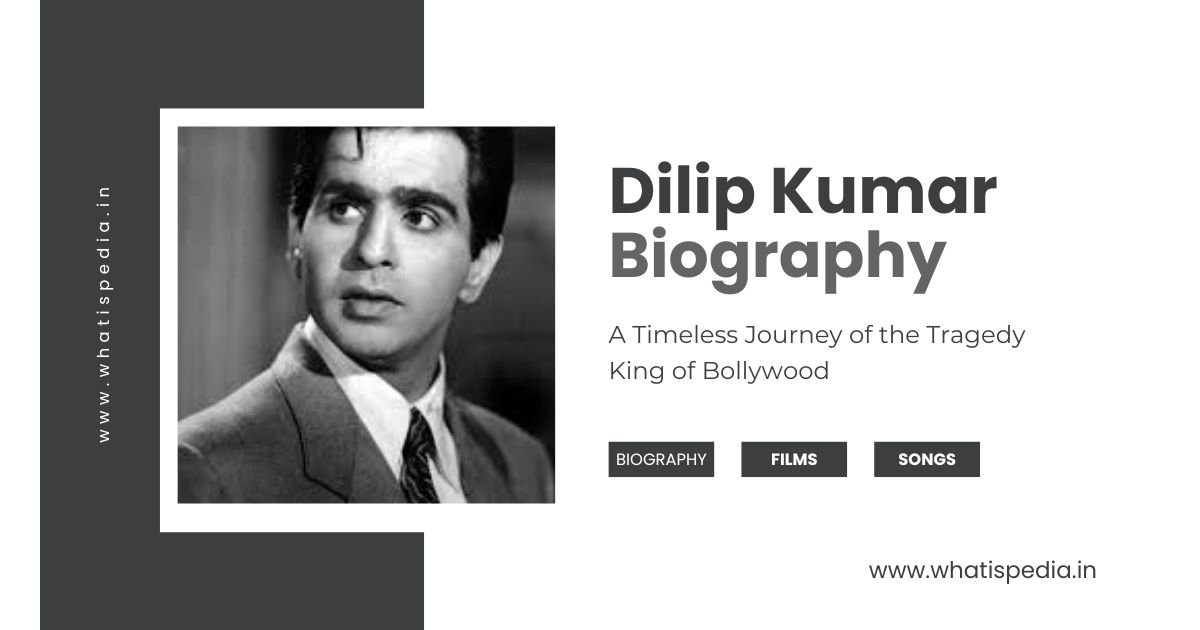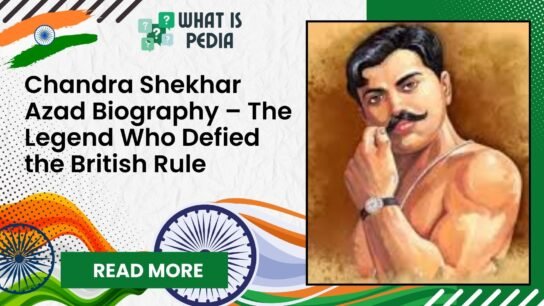1. Introduction
When we speak of timeless legends in Indian cinema, one name that resounds louder than most is Dilip Kumar. Revered as the “Tragedy King of Bollywood,” he wasn’t just an actor; he was an institution in himself. His ability to breathe life into every character, his iconic dialogue delivery, and his emotional depth marked a turning point in Indian cinema. Over the decades, his presence on screen became synonymous with cinematic brilliance and poetic emotion.
Who is Dilip Kumar? Born during the pre-independence era, he witnessed and contributed to the transformation of Indian cinema from its black-and-white days to the advent of color and sound revolution. A pioneer of method acting before the term even gained popularity, Dilip Kumar shaped the careers of countless actors who followed in his footsteps. His impact wasn’t limited to the silver screen—it transcended generations and borders.
Through this blog, we delve into the fascinating Dilip Kumar biography—a tale of dreams, discipline, talent, and timeless legacy. We explore his early life, rise in the film industry, legendary performances, personal life, awards, and the indelible impact he left behind.
So, whether you’re a long-time admirer or someone just discovering this iconic actor, this blog will answer every query you have about Dilip Kumar, including “Who is Dilip Kumar?”, “What was Dilip Kumar age?”, “What is the real name of Dilip Kumar?”, “Which was Dilip Kumar’s first movie?”, “What was the last movie of Dilip Kumar?”, and “Why is he the most Filmfare Award winner?”
Let’s embark on this cinematic journey through the life and legacy of the immortal icon—Dilip Kumar.
2. Dilip Kumar Real Name, Birth & Early Life
Born on December 11, 1922, in Peshawar, British India (now in Pakistan), the legendary actor we all know as Dilip Kumar was originally named Muhammad Yusuf Khan. For many fans, the revelation of Dilip Kumar real name is a surprising detail, symbolizing the era when artists often adapted screen names to resonate with the audience. His transformation into “Dilip Kumar” was suggested by Devika Rani, the head of Bombay Talkies, and marked the beginning of his journey into stardom.
Dilip Kumar age at the time of his passing on July 7, 2021, was 98 years. His life spanned almost a century—a period during which he not only witnessed history but also became a part of it.
He hailed from a humble Pathan family. His father, Lala Ghulam Sarwar, was a fruit merchant with orchards in Peshawar and Nashik. The family eventually migrated to Mumbai, where young Yusuf was exposed to various cultures, languages, and cinematic influences.
From an early age, he exhibited an introspective personality and a deep love for literature, sports, and music. He studied at Barnes School in Deolali, Nashik, and was fluent in multiple languages including English, Urdu, Hindi, Pashto, and Marathi.
Interestingly, before he ventured into cinema, Dilip Kumar tried his hands at entrepreneurship. He ran a small canteen and supplied dry fruits in Pune to support his family. Little did he know that destiny had other plans—and that he would go on to become one of the most iconic figures in Indian film history.
This phase of his life set the foundation for the man who would soon redefine acting for an entire generation. From Muhammad Yusuf Khan to the world-renowned Dilip Kumar, this transformation remains one of the most fascinating chapters in the biography of Dilip Kumar.
3. Entry into Films – The First Step Towards Stardom
The path to stardom wasn’t served on a silver platter for Dilip Kumar. His entry into the film industry was more accidental than planned. While working in Pune, he came into contact with Devika Rani, the matriarch of Bombay Talkies, who recognized his potential and offered him a break in films.
Dilip Kumar 1st movie was “Jwar Bhata” (1944), directed by Amiya Chakravarty and produced by Bombay Talkies. Although the film didn’t perform well commercially and failed to make a major impact, it was the beginning of something monumental. His early performances were raw but promising. He was a quiet observer, absorbing the nuances of acting and perfecting his craft with each role.
The post-war era saw a boom in the Indian film industry, and Dilip Kumar was ready to make his mark. He didn’t come from a theatre background like many of his contemporaries but had a deep understanding of human emotions. He studied the works of English authors, watched international films, and brought a subtlety to his acting that was previously unseen in Indian cinema.
During this time, he also worked hard to develop his on-screen persona. He changed his name from Muhammad Yusuf Khan to Dilip Kumar to appeal to a wider audience and to avoid family disapproval. It was a decision that forever etched the name Dilip Kumar into cinematic history.
Despite the slow start, within a few years, his talent became undeniable. Films like “Jugnu” (1947), opposite Noor Jehan, started gaining traction, and audiences began to recognize his emotional depth and charm. The biography of Dilip Kumar would soon be defined by a series of iconic films that made him a household name across India.
The struggles, the name change, the rejections—each element added a unique layer to the story of Dilip Kumar, making his journey not just inspiring but legendary.
4. Rise to Fame – The Tragedy King Emerges
By the late 1940s, Dilip Kumar was becoming a prominent figure in the Indian film industry. However, it was the 1950s that truly marked his golden era. During this decade, he starred in a string of critically acclaimed and commercially successful films that earned him the title of “Tragedy King”.
His performances in films like “Andaz” (1949), “Deedar” (1951), “Devdas” (1955), “Madhumati” (1958), and “Yahudi” (1958) showcased his unparalleled ability to portray emotional depth. His portrayal of doomed lovers and heartbroken souls resonated deeply with audiences, making him a master of tragic roles.
The film “Devdas”, directed by Bimal Roy, is often cited as one of his finest performances. As the ill-fated lover battling inner demons and societal constraints, Dilip Kumar delivered a performance that remains etched in the hearts of millions even today.
What set Dilip Kumar hero roles apart was the intensity with which he approached them. He internalized the characters and often remained in character off-screen to maintain emotional consistency. His acting method predated method acting trends seen in Hollywood, making him a true pioneer in cinematic performance.
His pairing with top actresses like Nargis, Madhubala, Meena Kumari, and Vyjayanthimala created cinematic magic. Films like “Mughal-e-Azam” with Madhubala showcased their unmatched chemistry and storytelling grandeur.
One of the significant features of this era was his collaboration with legendary directors like Mehboob Khan, K. Asif, and Bimal Roy. Under their guidance, Dilip Kumar honed his craft and brought forth some of the most iconic performances in Bollywood history.
As the Dilip Kumar biography progressed, it became clear that he wasn’t just a film star—he was a cultural phenomenon. People didn’t just watch his films; they felt them.
At a time when actors relied on theatrical expressions, Dilip Kumar introduced a new style—subtle yet powerful, internal yet expressive. His work inspired generations of actors including Amitabh Bachchan, Naseeruddin Shah, and Shah Rukh Khan.
By the end of the 1950s, Dilip Kumar had firmly established himself among the top Bollywood actors, admired not just for his on-screen talent but for his intelligence, humility, and grace.
5. Dilip Kumar’s Versatility – Beyond Tragedy
Although best known for his tragic roles, Dilip Kumar was by no means limited to a single genre. His versatility allowed him to shine equally in comedy, romance, drama, and historical epics.
One of the most remarkable examples of this versatility was “Ram Aur Shyam” (1967), where he played a double role—one timid and the other bold. The film was a box-office hit and showcased his excellent comic timing and ability to switch characters effortlessly.
Another iconic film that highlighted his range was “Mughal-e-Azam” (1960), where he portrayed the rebellious Prince Salim. His regal presence, combined with his romantic chemistry with Madhubala, made the film an eternal classic.
He also starred in films like “Kohinoor,” “Leader,” “Gunga Jumna,” and “Naya Daur,” each role distinct in character, genre, and emotion. His portrayal of rustic characters in “Gunga Jumna,” where he even spoke in the Awadhi dialect, was ahead of its time.
Despite his tragic image, Dilip Kumar never shied away from experimenting with roles that challenged his own stereotype. He believed in evolving with time, and his filmography is a testament to his commitment to art.
6. Last Movie of Dilip Kumar and Retirement
The 1980s and 90s marked the twilight years of Dilip Kumar’s illustrious career. Although he appeared less frequently on screen, his presence was still as commanding as ever. He took on mature and character roles in films like “Kranti” (1981), “Shakti” (1982), and “Karma” (1986).
His final appearance was in the 1998 film “Qila,” a courtroom drama where he played a double role once again. Though the movie didn’t create the same magic as his earlier films, it was a memorable farewell to a glorious cinematic journey.
After “Qila,” he quietly stepped away from the limelight, marking the end of an era. The last movie of Dilip Kumar might not have been a blockbuster, but it carried the weight of his incredible legacy.
(continued in next message…)
Here’s the continuation and conclusion of your blog “Dilip Kumar Biography: A Timeless Journey of the Tragedy King of Bollywood”:
7. Awards, Recognition & Contribution to Indian Cinema
Dilip Kumar’s contribution to Indian cinema is unparalleled. Over the course of five decades, he delivered landmark performances and helped define the very fabric of Bollywood storytelling. His unparalleled contribution earned him numerous awards and accolades:
Filmfare Awards: He holds the record for the most Filmfare Best Actor wins (8 times) and was also the first-ever recipient of the Filmfare Best Actor Award in 1954 for Daag.
Padma Bhushan (1991) and Padma Vibhushan (2015): Among the highest civilian awards in India.
Dadasaheb Phalke Award (1994): India’s highest award in cinema.
Nishan-e-Imtiaz (1998): Pakistan’s highest civilian award—making him the only Indian actor to be honored by both India and Pakistan.
CNN-IBN Lifetime Achievement Award and multiple other lifetime recognitions from national and international bodies.
Dilip Kumar’s artistry wasn’t confined to personal glory—he laid the foundation for method acting in Bollywood, set a benchmark for screen presence, and inspired countless actors including Amitabh Bachchan, Shah Rukh Khan, and Aamir Khan.
He was also nominated to the Rajya Sabha in the 2000s, demonstrating his influence beyond cinema.
8. Personal Life, Marriage & Faith
Off-screen, Dilip Kumar was a man of grace, intellect, and principles. He had a long-standing relationship with fellow actress Madhubala, though their love story was famously left incomplete. Eventually, he married the stunning and talented actress Saira Banu in 1966—he was 44, and she was just 22.
Despite the age difference, their bond lasted over five decades and was one of the most cherished relationships in Bollywood history. Saira Banu stood by him through every phase—his peak, retirement, and his later health struggles.
There has been curiosity around Dilip Kumar religion, and yes, he followed Islam. He was a devout yet secular man who deeply respected all faiths, earning admiration across communities and countries.
Though he didn’t have children, his legacy lives on through his films and the countless hearts he touched.
9. Death and Legacy
On July 7, 2021, Dilip Kumar passed away at the age of 98 due to prolonged illness. With his passing, an era ended. Fans, politicians, fellow actors, and global leaders mourned the death of a cinematic giant.
His funeral was attended by luminaries from all walks of life and was accorded state honors. Tributes poured in from across the globe. The Tragedy King of Bollywood left behind a legacy that few could match and none could replace.
His impact on Indian cinema is immortal. He wasn’t just a star—he was the soul of Bollywood. From the black-and-white charm of Andaz to the historical grandeur of Mughal-e-Azam, from the emotional depth of Devdas to the rustic brilliance of Gunga Jumna, Dilip Kumar redefined acting in Indian films.
10. Conclusion: The Man Behind the Legend
To summarize the Dilip Kumar biography is to try and encapsulate a phenomenon. He wasn’t just India’s greatest actor—he was also an embodiment of humility, intellect, and humanity.
From Muhammad Yusuf Khan to Dilip Kumar, his journey is one of dedication, transformation, and relentless pursuit of excellence. His characters cried, fought, laughed, and loved with such depth that they became unforgettable.
Whether you searched for Dilip Kumar age, real name, first movie, or last movie—what you discover is much more than facts. You discover a timeless soul who influenced Indian cinema like no one else.
In a world constantly chasing fame, Dilip Kumar stood for substance over style, art over theatrics, and grace over glamour. And that’s why, even after his death, his stardom continues to shine.

Read More: Manoj Kumar Biography: Life, Legacy & Unforgettable Films of a Patriotic Legend







